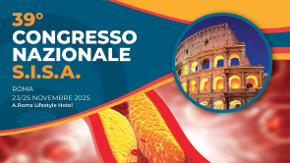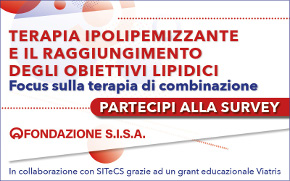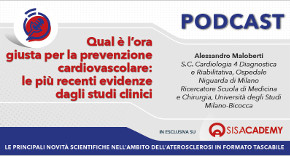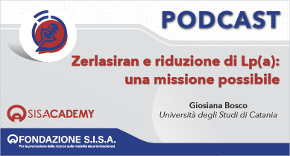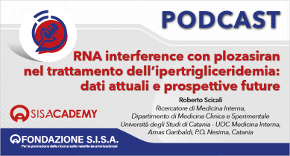 Rivista in lingua italiana
Rivista in lingua italiana
riservata ai Soci SISA
Ultimo numero:
Anno 16 • N.1/2025
SISANews
Bassa compliance alle linee guida per la prescrizione di farmaci ipolipemizzanti in pazienti diabetici e ipercolesterolemici
La gestione del diabete mellito di tipo 2 comprende il controllo glicemico intensivo insieme al trattamento delle comorbilità e delle complicanze per gestire l'aumento del rischio di malattie cardiovascolari. Pertanto, le linee guida raccomandano farmaci ipolipemizzanti per il trattamento dei pazienti affetti da diabete con LDL-C sopra le soglie di rischio. In questo studio nazionale, la prescrizione di farmaci ipolipemizzanti nei pazienti diabetici era presente in metà dei pazienti in prevenzione primaria e nei tre quarti di quelli in prevenzione secondaria.
![]()
Prescription of lipid-lowering medications for patients with type 2 diabetes mellitus and risk-associated LDL cholesterol: a nationwide study of guideline adherence from the Swedish National Diabetes Register
Karlsson SA, Franzén S, Svensson AM, Miftaraj M, Eliasson B, Andersson Sundell K.
BMC Health Serv Res 2018;18:900
BACKGROUND: Management of type 2 diabetes mellitus (T2DM) encompasses intensive glycaemic control, along with treatment of comorbidities and complications to handle the increased risk of cardiovascular disease (CVD). Improved control of LDL-cholesterol (LDL-C) with lipid-lowering medications is associated with reduced CVD risk in T2DM patients. Thus, treatment guidelines recommend lipid-lowering medications for T2DM patients with LDL-C above risk-associated thresholds. This study aimed to assess healthcare provider adherence to guidelines regarding lipid-lowering medication prescription among T2DM patients and to analyse factors associated with lipid-lowering medication prescription.
METHODS: Observations in 2007 - 2014 for T2DM patients age ≥ 18 were collected from the Swedish National Diabetes Register. Observations were excluded if they lacked information about LDL-C, lipid-lowering medication prescription or CVD. Observations with established CVD were attributed to secondary prevention; remaining observations were attributed to primary prevention. The analyses included primary and secondary prevention observations with LDL-C above risk-associated thresholds (LDL-C ≥ 2.5 mmol/l and LDL-C ≥ 1.8 mmol/l respectively). Guideline adherence was analysed as the probability of prescribing lipid-lowering medications using mixed-effect model regression adjusted for potential confounders. Factors associated with prescribing lipid-lowering medications were analysed for patient and healthcare provider characteristics using mixed-effect model regression and odds ratio.
RESULTS: A total of 1,204,376 observations from 322,046 patients reported by 1352 healthcare providers were included. Primary prevention accounted for 63%; 52% were men, mean age was 64 and mean LDL-C was 3.4 mmol/l. For secondary prevention, 60% were men, mean age was 72 and mean LDL-C was 2.7 mmol/l. During 2007-2014, guideline adherence ranged from 36 to 47% for primary prevention and 59 to 69% for secondary prevention. In general, concomitant prescription of diabetes medications, antiplatelets and antihypertensives along with smoking and specialised care were associated with higher prescription of lipid-lowering medications. Patients age ≥ 80 were associated with lower prescription of lipid-lowering medications. Higher prescription was associated with longer diabetes duration in primary prevention and men in secondary prevention.
CONCLUSIONS: Adherence to treatment guidelines levelled off after an initial increase in both prevention groups. Lipid-lowering medication prescription was based on individualised CVD risk.
BMC Health Serv Res 2018;18:900

Area Soci
Eventi
39° Congresso Nazionale
 39° Congresso Nazionale
39° Congresso NazionaleRoma, 23-25 novembre 2025
Save the date




 Spring Meeting Gruppi Giovani SID, SIGG, SIIA, SIMI, SIPREC, SISA
Spring Meeting Gruppi Giovani SID, SIGG, SIIA, SIMI, SIPREC, SISARimini, 6-8 aprile 2025
[continua a leggere]
 SISA LIPID ACADEMY - Corso avanzato di lipidologia clinica
SISA LIPID ACADEMY - Corso avanzato di lipidologia clinicaModena, 4-5 Luglio 2024
[continua a leggere]Giornale Italiano Arteriosclerosi
HoFH today
 Rivista Italiana della
Rivista Italiana della
Ipercolesterolemia
Familiare Omozigote
Anno 6 • N.1/2024
Rivista NMCD
Diateca
[continua a leggere]
[continua a leggere]
Newsletter
il vostro indirizzo di posta elettronica
Progetto LIPIGEN

Nuovo sito dedicato al Progetto LIPIGEN
Progetto LIPIGEN - Vecchio portale
E' necessario essere loggati come utente
Lipigen per poter accedere alla pagina
PROject Statin Intolerance SISA
PROSISA – PROject Statin Intolerance SISA
E' necessario essere loggati come utente
PROSISA per poter accedere alla pagina
GILA - Lipoprotein Aferesi
Gruppo Interdisciplinare Lipoprotein Aferesi
(Accesso Gruppo GILA-Lipoprotein Aferesi)
E' necessario essere loggati come utente del Gruppo GILA per poter accedere
Gruppo Interdisciplinare Lipoprotein Aferesi
(Documentazione ad accesso libero)
Pagina informativa per medici e pazienti


